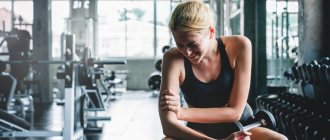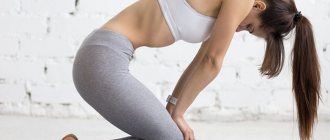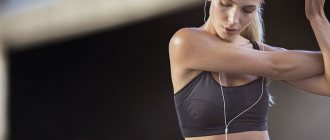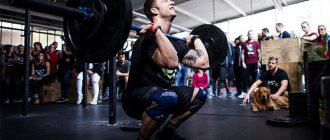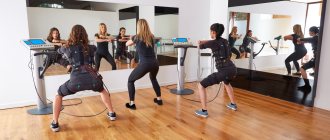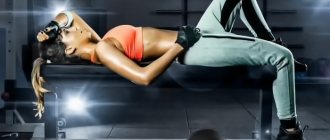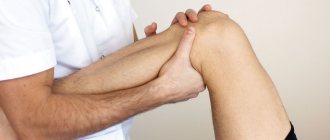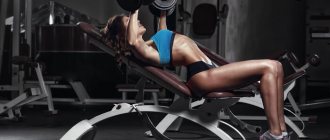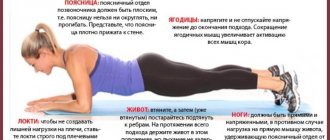Hello, hello my dears! Your Alena is with you again. After I decided to pump up my beautiful butt, I had to face an unpleasant problem. My gluteal muscles hurt after working out.
Of course, I started collecting information about why this happens and what to do about it, and I hasten to share with you. After all, apparently, many people know such pain after sports exercises.
Why do my buttocks hurt after training?
On the one hand, the fact that muscles hurt after training is good. It means we worked hard, and soon our butt will become what we dreamed of. Sometimes, on the contrary, beginners worry why their buttocks don’t hurt after regular exercise. Let's try to figure it out.
Krepatura, as athletes call muscle pain, occurs for a number of reasons:
- Lactic acid accumulation. This happens if you have just started exercising after a long break or if these are your first steps into the world of sports. Usually such pain goes away after a few days.
- Intensive load. During training, microcracks appear in the muscle fibers and it takes time for the muscles to recover. If you don't give your buttocks rest, the amount of muscle damage increases, and this is all accompanied by pain.
- About the same thing happens if you simply introduce new exercises into the complex or change the pace of execution. The new load damages the muscle fibers and pain appears.
- Sometimes, after training, your legs start to hurt, not your buttocks. This indicates that the technique of performing the exercise is impaired and it is not the butt that is being loaded, but the muscles of the thighs or calves, or the joints are damaged.
Important! If the pain occurs suddenly and does not subside over time, but rather becomes more intense, this is a signal that you have suffered an injury and will have to see a doctor.
Muscle pain after exercise
Diabetes
13169 03 March
IMPORTANT!
The information in this section cannot be used for self-diagnosis and self-treatment.
In case of pain or other exacerbation of the disease, diagnostic tests should be prescribed only by the attending physician. To make a diagnosis and properly prescribe treatment, you should contact your doctor. Muscle pain: causes of occurrence, what diseases it occurs with, diagnosis and treatment methods.
Definition
Muscle pain that occurs after physical activity is called sore throat. Soreness is a kind of indicator of stress on the muscles - the stronger the post-workout pain, the more stress the muscles experienced.
Types of muscle pain after exercise
There are several types of pain that occur after training:
- moderate post-workout muscle pain - appears the day after training, has a pulling nature and intensifies when the corresponding muscle contracts or stretches;
- delayed muscle pain - develops 2-3 days after training, has a strong aching character;
- traumatic muscle pain - occurs during exercise, immediately after or the next day, is acute and constraining in nature.
Possible causes of muscle pain after physical activity When
muscles contract, they consume oxygen, which is necessary for their effective functioning - the more intense and frequent the contractions, the more oxygen is required by muscle cells (myocytes).
If muscles experience hypoxia (lack of oxygen), then another method of “extracting” energy is activated – anaerobic glycolysis.
Anaerobic glycolysis is the process of energy production by body cells through various transformations of glucose with the release of adenosine triphosphate (ATP), occurring under anaerobic (oxygen-free) conditions. In other words, as a result of the breakdown of glucose, a certain amount of ATP molecules are released, which provide energy, and lactic acid (lactate), the excess of which leads to muscle soreness after exercise.
The lactate content in the cells of a healthy person ranges from 0.6 to 1.3 mmol/l; this indicator is used to evaluate the quality and intensity of muscle oxygen saturation and the quality of carbohydrate metabolism. In some diseases accompanied by seizures, lactate levels are higher than normal.
Lactic acid is normally found in the cells of the liver, brain, muscles, heart and other organs.
In the liver, the process of reverse glycolysis occurs - a chain of chemical reactions, as a result of which glucose is obtained from lactic acid, which is used for further transformations to produce energy.
Another cause of pain after physical activity is muscle microtrauma. More often they occur in people who exercise irregularly. In an untrained person, the muscle fibers contain myofibrils (the main contractile elements of muscles) of different lengths - short and long. During eccentric exercise (when tense muscles lengthen under load), the short myofibrils are torn.
What diseases can cause muscle pain?
Lactic acid can accumulate not only in people who exercise occasionally. Lactate levels increase in a number of diseases - such as diabetes mellitus, kidney damage, leukemia, sepsis, acute blood loss, etc.
A pathologically high level of lactic acid leads to the development of such a life-threatening condition as lactic acidosis, as a result of which the acidity of the body’s environment changes, which leads to disruption of the functions of all systems and organs at the cellular level.
Which doctors should I contact for muscle pain?
Before you start visiting a gym or fitness center, it is advisable to undergo a preventive examination and take a series of blood tests.
If any pathology is detected, the intensity of training, its volume, duration and frequency should definitely be discussed with a fitness instructor or sports medicine doctor.
Diagnosis and examinations for muscle pain
As a rule, muscle pain goes away on its own after training. However, a preventive examination and research results will allow a trainer or fitness instructor to adjust individual training, preventing the development of muscle pain.
For the convenience of patients, the INVITRO laboratory has developed special sets of examinations for men and women of different age groups (men over 25 years old, over 40 years old, over 50 years old; women over 25 years old, ), which include examinations by specialists and certain tests to evaluate the work body and identify the presence or risk of developing diseases of the bronchopulmonary, cardiovascular, endocrine and other systems.
What to do if you experience muscle pain after exercise?
A lack of microelements in people involved in sports can cause a malfunction of organ systems. There are a number of screening examinations that allow timely identification and replenishment of the level of missing substances.
How much to exercise so that your muscles don't hurt?
After the first classes, pain always arises and you just have to come to terms with it. As you continue training, you gradually accustom your muscles to the loads, and the pain disappears.
The training schedule should be designed in such a way that there is a break between classes. One or two days of rest are enough for microtraumas to heal and muscles to recover.
You need to increase the load and introduce new exercises gradually, then, perhaps, soreness can be avoided.
Be sure to start your workout with a warm-up. This will allow the muscles to warm up and reduce the likelihood of injury.
Attention! After a set of exercises, spend 10 minutes stretching. Trained muscles stretch well, which increases their elasticity and promotes relaxation.
If you maintain regular exercise, do not neglect warm-up and stretching, and gradually increase the load, then the training will be effective, but without the appearance of muscle pain.
Myths about the gluteal muscles
It turns out that among newcomers to the sport, like me, several erroneous judgments, so-called myths about how to properly train the butt, are common:
- If your buttocks don’t hurt after exercise, then the workout was wasted. Actually this is not true. Muscles may ache after a long break from exercise or after increasing the load or using a new set of exercises. With regular training, muscle fibers are not injured and therefore do not hurt.
- After squats, your butt will be pumped up well. In general, everything is correct and this exercise works the gluteal muscles well, but other movements must be included in the complex.
- You should give preference to exercises with heavy weights. During training, you need to target both fast and slow muscle fibers. Therefore, it is optimal to alternate a large number of repetitions with a small weight and several repetitions with a large one.
- The load on the butt muscles needs to be constantly increased. In principle this is true. The muscles get used to the usual load, and the training does not bring results. But first of all, you need to focus on sensations. If you feel like your butt is on fire during training, then you can take your time with increasing the load.
- Once a week is enough to work the buttocks. If the main goal is to pump up your butt, then you can and should exercise at least 4 times a week. The buttock muscles are large and durable, so they do not require long-term recovery.
- A couple of exercises are enough to pump up your butt. Not true. There are many muscles in the buttocks and each one needs attention, so the complex should include exercises for different groups of gluteal muscles.
The mechanism of pain in the coccyx during physical activity
How does pain in the tailbone appear after training? If you feel discomfort in the tailbone area during or after exercise, then most likely the load on the muscles was excessive or you violated the exercise technique and suffered a sprain or injury. If pain appears the next day or after some time, this indicates the presence of a serious injury, which is aggravated by constant stress, as well as internal pathologies and diseases, such as a hernia. If pain persists for a long time, it is possible that the damage has affected not only the muscles and nearby tissues, but also internal organs.
How to relieve pain from muscles after exercise?
How to relieve pain after training. There are several effective methods:
- a hot bath followed by rubbing the buttocks with a washcloth or hard towel will warm up and stretch the muscles, improve blood circulation and speed up the elimination of lactic acid;
- bath or sauna. The principle of operation is the same, but in the bathhouse an additional assistant is a broom;
- a contrast shower after a workout is also quite capable of relieving muscle pain;
- massage. This is probably the best remedy for recovery after exercise;
- rubs, creams and ointments that have a warming, analgesic or cooling effect will be very useful for treating areas where soreness is felt.
You can, of course, resort to the help of analgesics, but it is still better not to poison the body with medications once again, but to choose a safer and simpler way to relieve pain. In addition, do not forget that ordinary clean water helps the rapid restoration of muscle fibers. Make it a rule to drink 6-8 glasses of cool water daily. This will not only reduce the recovery period, but also speed up metabolic processes and fat burning.
That's it, my dears. As they say, beauty requires sacrifice, therefore, striving for an ideal body, you will have to put up with such unpleasant manifestations as muscle pain after training. Well, or carry out classes according to all the rules: regularly, gradually increasing the load and giving rest to the worked muscles. Smack everyone!
